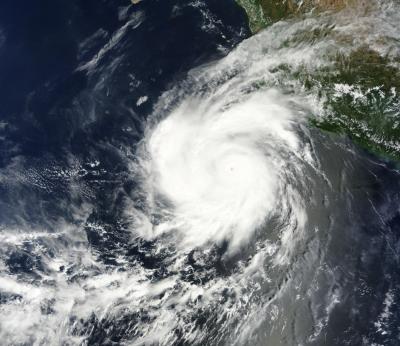Recurving Eastern Pacific hurricanes reduce Southwest U.S. Wildfires
A majority of Eastern Pacific (EP) hurricanes travel westward toward the Central Pacific region after forming due to the climatological steering flow, which is predominantly easterly. However, during the late-season months of September-October, when the steering flow becomes favorable for recurving, EP hurricanes can travel farther north and reach the arid Southwest U.S. region. Consequently, they produce much rainfall over that region and increase soil moisture, reducing the vapor pressure deficit, conditions that are less favorable for wildfires.
While the contribution of EP hurricanes to the Southwest U.S. precipitation has been discussed previously, their potential role in wildfires was hitherto unexplored. In this study, using a combination of observations and E3SM simulations, we demonstrate that recurving EP hurricanes can modulate the prevalence of wildfires in the Southwest U.S. Also, we show that there has been a long-term decline in the Southwest U.S. precipitation associated with recurving EP hurricanes. Our study suggests that improving the seasonal prediction of EP hurricanes may lead to better forecasts of September-October wildfires in that region. The study also suggests that the long-term decline in Southwest U.S. precipitation associated with EP hurricanes may have contributed to the increase in wildfires and drought-like conditions over time in that region.
Using observations and E3SM simulations, a PNNL research team systematically demonstrated that recurving EP hurricanes may reduce the prevalence of wildfires in the Southwest U.S. First, researchers used observations to show that during recurving EP hurricanes, precipitation and soil moisture increases, and vapor pressure deficit decreases, over the Southwest U.S. Next, they used E3SM simulations to support these observational results. Specifically, the North American Regionally Refined Model (NARRM) configuration of E3SM, which can explicitly resolve EP hurricanes is used. Further, to understand the implications for wildfires, the team analyzed direct observations of wildfire burned areas. The analysis reveals that during years with recurving EP hurricanes, the wildfire burned area during September-October is reduced. Importantly, this impact of EP hurricanes on wildfires is independent of the influence from the North American Monsoon and Santa Ana Winds. Finally, analysis of historical E3SM NARRM simulations indicates that there has been a long-term decline in EP hurricane activity, and their ability to deliver water to the arid Southwest U.S. region. These results have substantial implications for Southwest U.S. wildfire predictability at seasonal and longer timescales.

